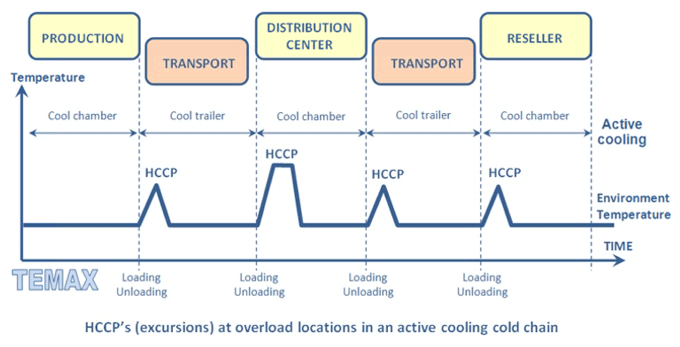You are here: English > Cold Chain > Cold chain active cooling
To maintain temperatures to transport or store temperature sensitive goods, two different kind of cooling techniques can be used being an active cooling or a passive cooling. If we talk about an active cooling we mean that a mechanical or electrical cooling engine is creating cooled air which is blown in a certain environment or chamber controlling the temperature of the products in the chamber. The big advantage of this active cooling is that the temperature can easily be regulated. Just set the cooling engine on the needed temperature and you are ready to go. A big disadvantage of active cooling, next to the high cost and energy usage, is that the cold chain is almost never totally closed and multiple points will be noticeable in the cold chain where the temperatures can fluctuate. When a cold chain is build up with only active cooling systems than this means that each actor in the chain as producers, transport companies, distribution centers, resellers, freight forwarders, airline and sea freight companies, etc… are equipped with active cooling techniques as temperature controlled trucks, cooled chambers etc… The problem with active cooling is that the product itself is unprotected. This means that if the product gets in contact with unwanted environments or temperatures, the temperature of the product will fluctuate significant. This fluctuation also called CCP’s (Critical Control Points) can appear at overload procedures between two cooled environments, time needed for the cooler engine to produce the required temperature, etc… This means that it is very difficult to close the total cold chain when active cooling is used. The more actors in the cold chain who handle the temperature sensitive product, the harder it will be to totally close the cold chain.
H.C.C.P.'s "Hazardous Critical control Points" in an active cooling cold chain
Analysis is part of HACCP-plan and-or G.D.P.-plan (Good Distribution Practice). If active cooling is used in the total cold chain, you could be surprised on the number of points or HCCP’s in the chain where the temperature can fluctuate and the impact of these points. In the food industry, where the norms are very high, these points are known as HCCP’s or “Hazardous Critical Control Points” meaning that these points, where the temperature can fluctuate, need to be studied especially. Further, the food industry states that these HCCP’s need to be noted in a HACCP plan or GDP in pharmaceuticals which mentions how the HCCP’s are monitored and how they are prevented or solved. Also in the pharmaceutical industry these HCCP’s are appearing when active cooling is used in the cold chain of pharmaceuticals and medicines. As mentioned before, these points mostly appear at overload procedures when the goods are being loaded from one temperature controlled environment into another. If we would place the temperature fluctuations at the HCCP’s on an active cooled cold chain with just road transport, we would see the following situation.

The above graphic show a cold chain in which all the actors in the chain use active cooling. The temperature graphic (red line) show the possible temperature fluctuations which appear in the HCCP’s. The folowing questions should be asked:
- How many actors are active in the total cold chain or how many HCCP’s are appearing in the total chain
- What is the impact of these HCCP’s being: duration that each HCCP is active and the height of the temperature fluctuation during each HCCP’s
- How will all these HCCP’s influence the quality of the goods
HCCP's in air or sea transport
If temperature controlled goods are send with active cooling on air or sea transport, the HCCP’s “Hazardous Critical Control Points”, where temperature fluctuations can appear will be increased significant. Not only the number of actors, which take part in the distribution chain or cold chain, will increase but also the transport duration and temperature fluctuations will increase. If goods are send worldwide by air or by sea extreme high temperatures (Dubai in summer time) or extreme low temperatures (Canada in winter time) can be measured. This means that the HCCP’s will have a big impact on the temperature results and the quality of the goods. If we take air transport for example, experience show that the tarmac is a big HCCP. The tarmac is the location on the airfield were the goods are loaded or unloaded from the airplane and were no protection is offered which means that the goods are standing in the open under the influence of the local weather conditions.
Passive cooling to tackle the HCCP's in the active cooling cold chain
Active cooling, creating a temperature controlled environment with a cooling engine, in a cold chain is very effective when the products are standing in the temperature controlled environment for a long time. That is a known fact. If active cooling is used in a cold chain, where the products changes from one temperature controlled environment into another, the overload can cause HCCP’s where the temperature can fluctuate. This explains why more and more companies a combining active cooling systems with passive cooling systems to prevent the temperature from fluctuating during the HCCP’s.




